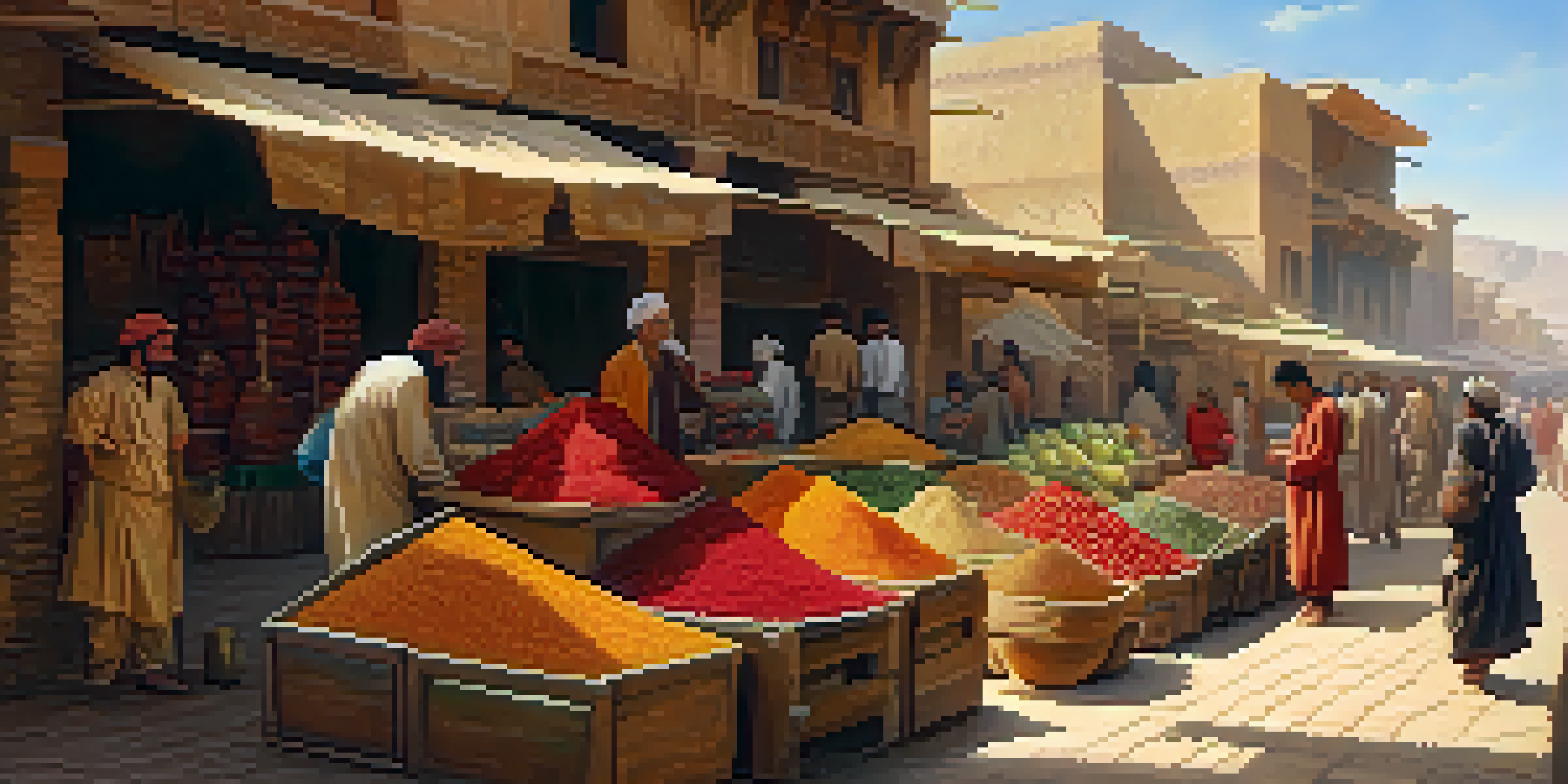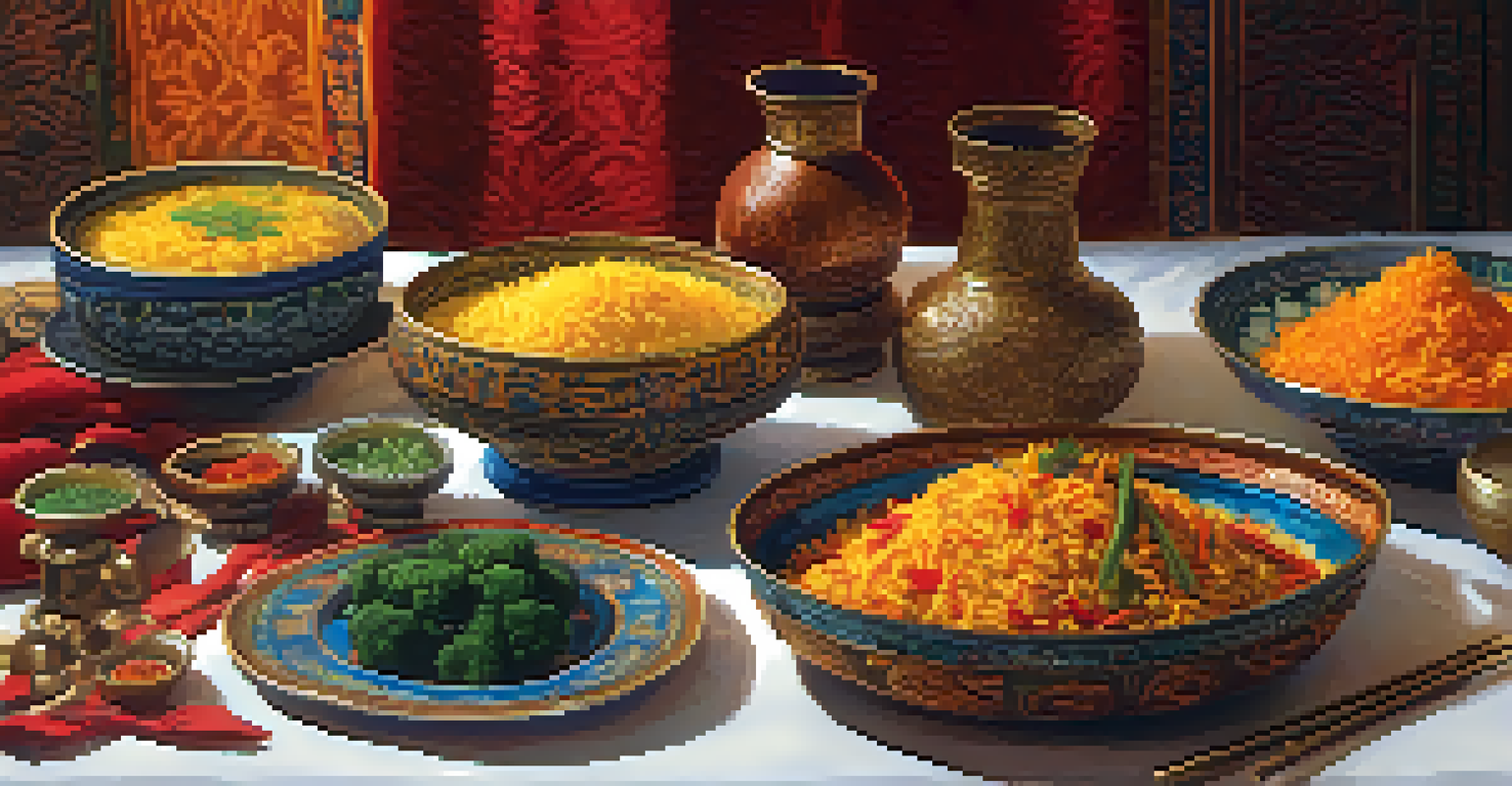The Influence of the Silk Road on Historical Cooking

Introduction to the Silk Road and Its Significance
The Silk Road was not just a series of trade routes but a vibrant network connecting East and West. Spanning over 4,000 miles, it facilitated the exchange of goods, ideas, and cultures. As traders moved along these paths, they brought with them not only silk and spices but also culinary influences that would shape cooking traditions across continents.
The Silk Road was a great highway of cultural exchange, where ideas flowed as freely as goods.
The importance of this trade route cannot be overstated; it served as a melting pot where diverse cultural practices mingled. As merchants and travelers exchanged ingredients and recipes, they sparked innovation in local cuisines. This cross-pollination of food traditions has had a lasting impact, evident even in modern cooking.
In this article, we will explore how the Silk Road influenced historical cooking, examining the various ingredients, techniques, and culinary customs that emerged from this dynamic exchange.
Key Ingredients Brought by the Silk Road
One of the most notable impacts of the Silk Road on cooking was the introduction of new ingredients. Spices like cinnamon, pepper, and saffron traveled from the East to the West, transforming how people seasoned their food. These spices not only enhanced flavors but also played a crucial role in food preservation, especially before refrigeration.

Additionally, exotic fruits such as citrus and pomegranates made their way into various cuisines. Their vibrant colors and unique flavors inspired chefs to experiment and innovate. This blending of flavors gave rise to new dishes that reflected a fusion of cultures, showcasing the importance of the Silk Road in culinary evolution.
Silk Road's Culinary Exchange
The Silk Road facilitated the exchange of ingredients and cooking techniques, enriching global cuisines.
The introduction of these ingredients marked a turning point in cooking practices, allowing for a diversity of flavors that was previously unimaginable.
Culinary Techniques Influenced by Cultural Exchange
As traders exchanged not just goods but also cooking techniques, the Silk Road became a conduit for culinary innovation. Techniques such as stir-frying and the use of woks spread from Asia to other parts of the world. These methods revolutionized the way food was prepared, making cooking faster and more efficient.
Food is the universal language of mankind, transcending borders and cultures.
Moreover, the art of preserving food, whether through drying or pickling, also found its roots in these exchanges. Different cultures shared their methods, allowing for the preservation of seasonal ingredients for year-round use. This sharing of knowledge significantly expanded the repertoire of culinary techniques available to cooks everywhere.
The blending of techniques from various regions led to the creation of dishes that were rich in flavor and history, illustrating the profound effect of the Silk Road on global cooking practices.
Cultural Influences on Regional Cuisines
The Silk Road's influence went beyond just ingredients and techniques; it also affected the cultural significance of food. Different civilizations began to incorporate spices and cooking methods into their own culinary identities, leading to unique regional cuisines. For instance, the use of saffron became a hallmark of Persian cuisine, while the spice trade influenced Indian cooking profoundly.
Food became a symbol of cultural pride, and the fusion of flavors often mirrored the blending of societies. Festivals and celebrations began to showcase these culinary traditions, highlighting the importance of food in cultural expressions. Over time, these regional cuisines not only preserved history but also fostered a sense of community among diverse groups.
Cultural Significance of Food
The integration of diverse culinary practices along the Silk Road shaped regional cuisines and cultural identities.
Thus, the Silk Road played a pivotal role in shaping not just what people ate, but how they viewed food within their cultural contexts.
The Role of Religion in Culinary Practices
Religious beliefs significantly shaped culinary practices along the Silk Road. As traders and travelers moved, they brought their dietary restrictions and traditions with them, influencing local cuisines. For example, the Islamic prohibition of pork led to the development of alternative meat dishes in regions where Muslims settled.
Similarly, Buddhist principles of non-violence affected vegetarian cooking in many areas. This exchange of religious ideas often resulted in the adaptation of local dishes to accommodate different beliefs, leading to the creation of new, culturally rich recipes. The interplay of religion and cooking emphasized the importance of food as a reflection of one’s beliefs and values.
Ultimately, the Silk Road acted as a bridge, allowing various religious practices to coexist and influence culinary traditions.
Impact of the Silk Road on Trade and Economy
The Silk Road was integral to the economy of the regions it connected, especially in terms of food trade. Spices, dried fruits, and other culinary treasures became highly sought-after commodities. This demand not only enriched traders but also led to the establishment of markets and trade routes, further embedding food into the economic fabric of society.
As trade flourished, so did the exchange of culinary knowledge. Merchants often shared recipes and cooking tips, enriching local cuisines and encouraging culinary experimentation. This economic interdependence fostered a sense of community among traders and consumers alike, highlighting how food can unite people across vast distances.
Economic Impact of Food Trade
The Silk Road not only transformed cooking but also enhanced economies through the trade of sought-after culinary goods.
Thus, the Silk Road not only transformed cooking but also revitalized economies, demonstrating the powerful connection between food and trade.
Legacy of the Silk Road in Modern Cuisine
The legacy of the Silk Road continues to resonate in modern cuisine today. Many popular dishes around the world can trace their origins back to this ancient trade route. For example, the concept of fusion cuisine, where different culinary traditions meet, is a direct descendant of the exchanges that took place along the Silk Road.
Moreover, the global accessibility of spices and ingredients that were once exclusive to specific regions has democratized cooking. Home cooks can now experiment with flavors from around the world, creating dishes that reflect a rich tapestry of global influences. Restaurants often celebrate this heritage, showcasing menus that honor the diverse culinary traditions born from the Silk Road.

Ultimately, the Silk Road’s influence on cooking is a testament to the enduring power of cultural exchange, reminding us that food is a universal language that connects us all.